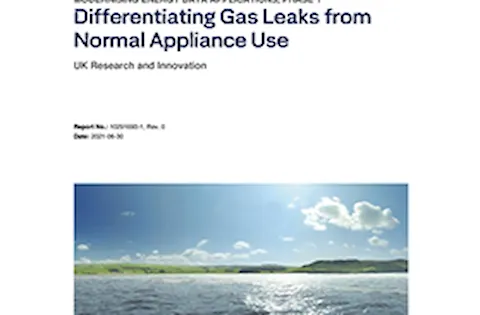Using smart meter data to drive improvements in gas safety
The first phase of our work to use UK gas smart meter data to drive improvements in safety has now drawn to a close. In this short article we’ll provide an overview of our progress and aspirations for the future.
An overview of the progress of our project - Smart metering leak detection which utilises the Open Energy data architecture being developed through projects funded under the previous MEDA competition.
To recap: our work aims to analyse the data that is already gathered by smart gas meters and use it for other purposes:
- To identify potentially dangerous gas leaks in houses by comparing real time data with previous patterns in gas consumption.
- To detect appliances that are performing inefficiently driving improvements in terms of energy efficiency for financial and environmental reasons.
- To enable efficient planning of maintenance and construction activities, particularly operations that sometimes require portions of the network to be isolated.
- To detect potential problems upstream of the meter on the gas networks.
- To facilitate the conversion of gas networks and supplies to hydrogen, or hydrogen blends as part of the drive to decarbonise and transition towards net zero.
- To drive smart meter uptake, improve public perception and stimulate innovation.
All of which we believe are activities that are underpinned through better use of gas smart meter data.
Sadly, since our work started back in April, there was another gas explosion in the UK on the 16th May in Lancashire, England with loss of life and a number of serious injuries as a result of a gas pipe being cut inside a neighbouring house.
Approach
A detailed assessment of possible leak sizes and appliance performance was carried out for three gas compositions: natural gas, a blend of 80% natural gas and 20% hydrogen, and pure hydrogen. A series of gas accumulation calculations were performed for a range of room sizes, across the full spectrum of leak sizes that are possible on internal pipework and from appliances. The enabled the outflow rates from leaks to be compared with the typical gas use of appliances, and for the timescales to reach flammable gas/air concentrations were to be determined.
For illustration, smart gas meter data was obtained for a real detached house with four occupants, fitted with a gas boiler (for space and water heating) and a gas oven. This example case was used to demonstrate different potential natural gas leak scenarios by overlaying the predicted gas outflow rates onto the gas use of the appliances. Smart gas meter data is currently available in 30-minute periods, expressed in terms of the energy use, rather than the volumetric flows.
The typical daily smart meter gas usage profile for a house is shown in Figure 1. The gas usage profile will have the typical patterns outlined, with low gas usage at night, peak gas usage in the morning and evening associated with bathing and cooking, and moderate flows in between associated with heating. This timing and size of usage will vary from house to house depending on work and holiday patterns of home owners, the make and model of boiler that has been installed and the weather. All these variables and more drive variable gas usage from day to day.
Analytics
To try and understand this gas usage pattern and determine if it is possible to detect leaks, the team started by reviewing the smart meter data from one household and looked at what data features were correlated with gas usage. Weather data, calorific value of gas and electric meter readings were some of the external sources of data that were explored for correlations.
The team also created meta-data features such as day of the week, month, the previous 30-minute gas reading and the previous week's 30-minute gas reading and many others to help model the gas flows and detect anomalies in the amount of gas used. Especially when trying to identify leak sizes which could be on the same magnitude as gas appliance being used.
As part of this study, several machine learning (ML) anomaly detection algorithms were trialled to see if it was possible to detect suspicious gas usage at the 30-minute level. Figure 2 shows a plot of actual gas usage for a house which, to our knowledge, does not contain any leaks. Figure 2 (a) shows an example anomaly detection algorithm (isolation forest) which looks to identify unusual gas readings based purely on the time of day.
Here the algorithm has detected two gas leak data points shown in red i.e. two false positives. Figure 2 (b) shows a ML algorithm that was trained to learn and predict the gas flow usage for a house. The solid blue line shows the actual gas usage, the dotted red line shows the absolute prediction value, and the orange shaded area shows the 10 to 99.9% prediction confidence boundary. Here the confidence intervals are high, and the algorithm performs well on training data but scores lower in testing (0.95 vs 0.61) suggesting a model which is overfitted. Nevertheless, a variety of algorithms were tried including random forest, gradient boosting regression, seasonal decomposition predictors and autoencoders. DNV will work to expand on these models and build a detection rule set as more data is used to help shape these algorithms and improve the accuracy to detect leak sizes on a par to appliance usage more rapidly.
The team also carried out a FMECA (failure mode, effects, and criticality analysis)and followed stages from DNVGL-RP-A203: Technology Qualification and DNVGL-RP-A204: Qualification and assurance of digital twins to ensure that the leak detection technology was developed according to the best practices.
Detection models
Simple methods can be used to detect large leaks at the end of the first 30-minute period outputted by the smart meter. This enables the leaks that typically lead to loss of life and severe property damage to be identified and addressed in many cases before the gas/air mixture can reach a flammable level and be ignited.
The detection of medium leaks, that have similar flow rates to normal appliance use, varies according to the size of the hole and appliance use at the time. Other factors such as historical gas use in the property and weather data can be used to improve the detection algorithm’s performance. Figure 3 illustrates how a simplified rule-based algorithm can be developed to identify leaks if more advanced models fail to provide adequate protection. As shown, the gas usage at 15:30 exceed any conceivable gas flow rate for the property and thus would alert the user to a gas leak.
Small leaks that would likely never form flammable gas/air mixtures might take some time to detect, as they are detected by looking at an entire day of gas readings, particularly when the gas usage is expected to be zero which is usually at night. This is not a critical safety issue and they can typically be identified in 12 to 24 hours.
A similar approach can also be used to detect unusually low gas use, for example to detect gas theft or identify fuel poverty cases to provide the necessarily support.
Target market
In terms of size of market, any households with a smart gas meter could use this technology (approximately 7.5 million homes in 2020), potentially rising to 22.0 million domestic gas meters with further smart meter installation.
Using our analytics, we believe almost all gas leaks can be detected with the most dangerous detected within 30 minutes, moderate in 1 to 6 hours and non-hazardous in 1 day.
Between 7% and 30% of explosions for households with smart meters (up to 75% of the most severe cases) could be prevented. Around one life could be saved each year (plus several injuries) if all homes were fitted with this technology. Other benefits include avoiding property damage, reducing environmental impacts, and financial savings, identifying gas theft and those in or at risk of fuel poverty.
The approach has been developed for natural gas but is almost identical for a transition to hydrogen, which could prevent a greater absolute number of explosion incidents.
A digital delivery model
DNV intend to trial the detection algorithms developed during Phase 1 on a larger sample of real smart meter data, developing an Application Program Interface (API) to assess data for gas leaks in real-time. A service that we like to call “safety as a service”.
Our API will allow a multitude of different customers and applications to obtain and process our insight data and identify issues within households. This route to market has been met with considerable excitement from industry as it allows the benefits we’ve outlined to be incorporated into existing tools, apps and solutions that exist today, rather than via another bespoke app that a user, customer, or industry has to install. It also reduces the amount of data in transit and avoids the creation of potential data siloes.
With the architecture proposed (Figure 4) we will also expand our API to work for multi-occupancy buildings, commercial businesses, hospitals, and public venues, whilst maintaining a solution without single vendor lock-in so that it can be utilised by anyone.
For additional information, please look at the video of our project team presenting our work. We’d love to hear your thoughts and reflections on our activities too – please do get in contact if you’d like to discuss further!
7/29/2021 10:51:42 AM

